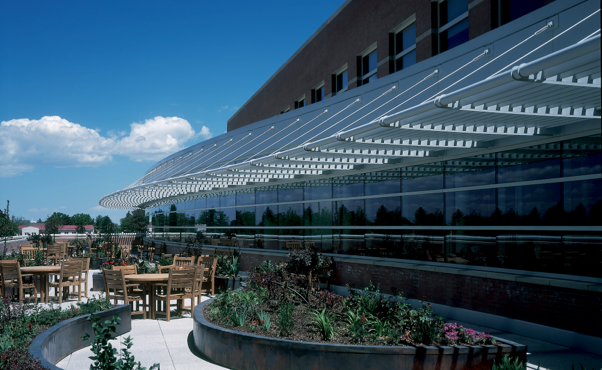 The Vision
The Vision
On February 2, 2004, the University of Colorado Hospital opened the beautiful new Anschutz Cancer Pavilion on the new Fitzsimons Campus located in Aurora, Colorado. Physicians, employees and patients participated in the design of the state-of- the-art $148.8 million hospital, helping the architects achieve a functional, efficient building with spectacular views of the nearby Rocky Mountains. An important sustainability goal was to maximize the use of natural daylight, while using energy efficient controls to turn-off light fixtures in corridors and exterior areas during bright daylight hours. The reliance on natural daylight resulted in the design team’s need to control glare and heat transmitted through glazing and window systems.
The Airolite Look…
A massive curvilinear window system frames the western view of the mountains from the ambulatory care center. This ten-foot high wall of glass paints a constantly evolving image of the changing seasons evidenced in the roof garden and the majestic Rocky Mountain backdrop. At the same time, this large expanse of glass poses monumental challenges for maintaining energy efficiency. The height of the glass wall dictated a monumental horizontal sun control projection of more than eight and one-half feet to shade the windows to inhibit thermal heat transmittance and glare during peak daylight hours.
A complimentary sun control design with a comparatively modest maximum 4′-0″ projection is utilized over windows in patient rooms located in the south-facing wall to support operation of the patient-operated environmental controls. A special fascia element maintains continuity of the horizontal linear configuration across the red masonry façade.
That Works
Notwithstanding the use of extruded aluminum elements to reduce the weight of the eight and one-half foot sun control assemblies, the extended projection resulted in significant moment forces transferred to the structure by the sun controls. This problem was addressed by departing from the window supplier’s standard frame, which was not designed to accommodate the substantial moment forces transferred by the sun control outrigger. Instead, a horizontal steel member was incorporated in the exterior wall design to address the loads transferred by the sun controls. The sun control outriggers are secured to the steel member with brackets which project through painted aluminum cladding. In addition, the maximum wind design forces required the use of diagonal stainless steel support rods to mitigate the moment forces transferred to the steel member located in the exterior wall design.
The designer elected to utilize vertical extruded aluminum tubes spaced six-inches on center to achieve crisp, uniform, and sharply defined sight lines for the sun control infill. The close center spacing of the vertical tube blades yield a sun cut-off angle that prevents sunlight from passing between the blades except at its maximum height. The hollow shape dissipates heat easily and is a rigid member that can accommodate the 5′-0″ maximum span without difficulty. To alleviate the costly and cumbersome task of fabricating each tube blade to the constantly changing radius, the factory-assembled sun control sections were designed to be segmented about the curvilinear window configuration.
Surprisingly, only the fascia element is radiused to lend the perception that the entire sun control system is comprised of a series of non-linear segments. Lastly, selection of a white fluoropolymer coating enhances the sun control’s capacity to deflect sunlight, head and glare from the windows below and through windows located above the sun control to enable diffused daylight to be projected across interior spaces.